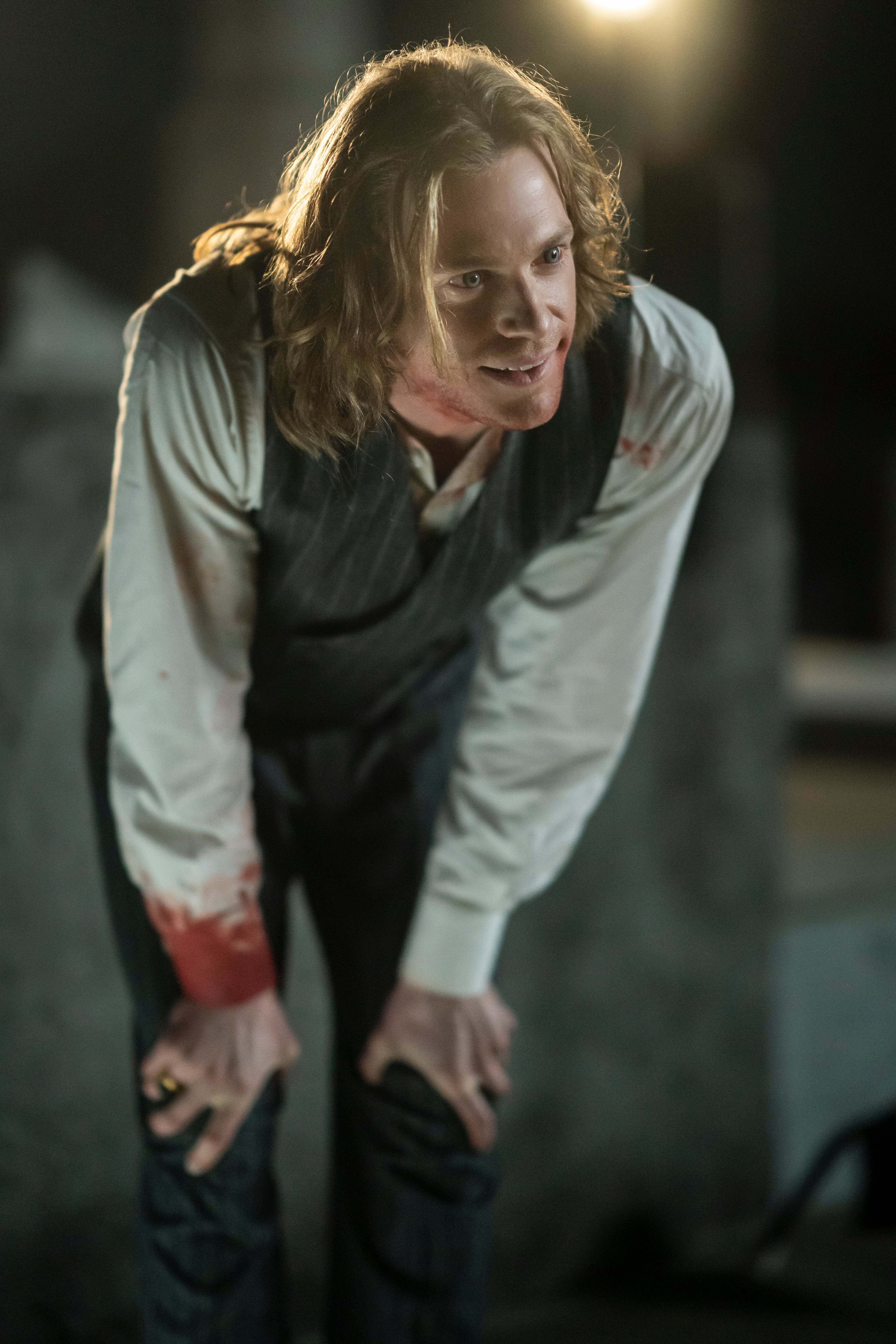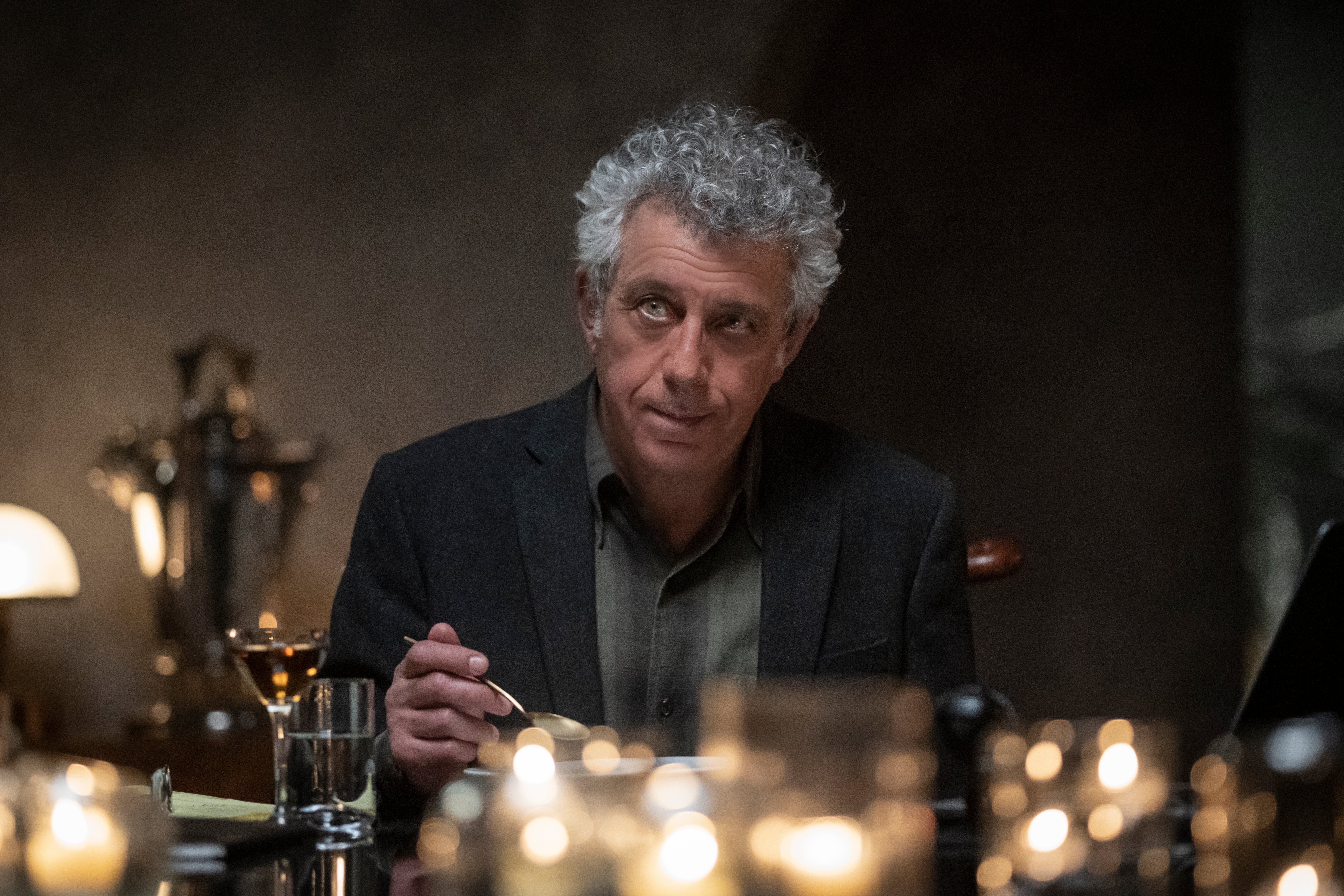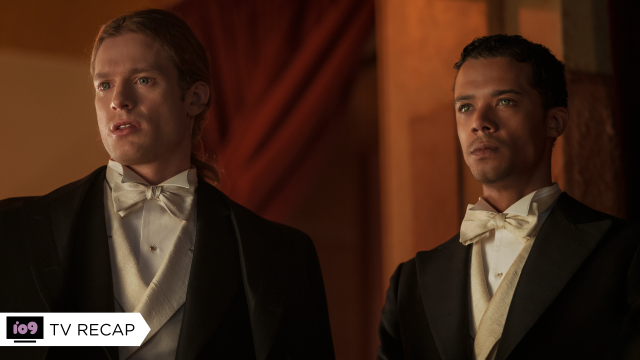This week’s episode of AMC’s Interview With the Vampire starts with Daniel Molloy (Eric Bogosian) observing a piece of art that does not really exist. The painting depicts Jesus reaching upwards to the heavens as small devils try to pull him down. As Molloy looks it over, Rashid (Assad Zaman) mentions that it was painted by a Venetian contemporary of Tintoretto, Marius de Romanus. If you’re familiar with the Vampire Chronicles at all, you know that Marius is another vampire from the series, one who takes Daniel under his wing in later books. The piece is not a forgery, or a fake, but a uniquely fictional piece of Renaissance artwork, dominating the wall of this sleek, sophisticated, ultra-contemporary apartment.
To fans of the show, or even casual fans of the Vampire Chronicles, this Easter egg is not much of anything — a single name dropped in an ocean of other, more frightening, bloodier stuff. The painting might as well not exist. But this short opener is part of the larger framing of this reinterpreted Interview With the Vampire; demonstrating that this show is deeply concerned with conveying a meticulous, studied understanding of the original while also creating something entirely, completely new. A piece of art that only exists inside of a world that it has made.
I’m less than two minutes into the episode, titled “After the Phantoms of Your Former Self,” and I promise I’ll try to keep focused during this recap, but I cannot overstate how much I love these details. Especially when it comes to artwork, as the art selection in Louis de Pointe du Lac’s apartment is… full of very interesting choices. More on that later.
After he’s done observing the de Romanus, Daniel takes a seat at the table, having been informed that Louis will join him after the seventh course. What follows is an incredible parade of rich, expensive, and absolutely over the top dishes. Foie gras, champagne, lobster. It’s unclear if Louis is attempting to impress Daniel or prove that he is sophisticated, as if he needs Daniel to know that he can be human, the most gracious kind of human, if he really tries hard enough. Across the table, as Daniel is served ajo blanco (bread, crushed almonds, and salt, garnished with green grapes), Louis is served AB negative, “fresh from the farm.”

We go quickly into Louis’ transformation, back in 1910, as dies. Lestat calmly carts a corpse through an above-ground cemetery. He’s blithe, casually cruel, and behind him Louis retches, in the throes of death. And then Louis transforms; he starts to walk through the streets he immediately becomes predatory. He hunches, his eyes wide, analysing his new prey. As Lestat guides Louis they beguile a hapless tractor salesman home and make of him Louis’ first meal. Louis watches from the stairwell as Louis attacks viciously. “The neck, bite the neck, Louis,” he says, only slightly concerned. “You don’t bite the blood, you suck it.”
It takes no time at all for Louis to feel regret. He immediately tries to run, but it’s morning, and the sun is up. Lestat pulls him back into the house, and they go upstairs. Louis is led into the bedroom, the coffin is revealed, and Lestat remarks that this is the perfect setting for a vampire romance. He strips, invites Louis into his coffin, and smirks, telling Louis that he “can be on top.” It is deeply disturbing and, at the same time, ridiculously sexy.
When we come back to Daniel and Louis they’re trading barbs over the dinner table. Louis kills a small fox, Daniel eats rabbit three ways. They continue to bicker about theories of life, death, and detachment over dinner.
In New Orleans again, we see Louis and Lestat out on the town. Flirting. It’s charming, it’s cute. We can almost forgive the murder. Lestat continues to teach Louis more about his powers as a vampire. As they discern each human to think only of food, fucking, or going home, Louis challenges Lestat, smirking. “What am I thinking right now?” Lestat turns to him, slowly. “You’ll have to tell me yourself.”
By giving us these moments of charm and cleverness wrapped around explainers of vampire lore — which in this series is bizarre, strange, not quite what we would expect — the story naturally attaches anecdotes to worldbuilding, creating a tableau without pointing out the camera in the background. It’s exceptionally good writing, and carried along by a swiftly moving plot and the narrative reflection that occurs within the frame story between Louis and Daniel.
Louis returns to his home during a celebration, and he quickly encounters the double edged sword of his supernatural senses — in between his family, his business dealings, and even the people he would consider his social circle, all the power in the world can’t give him respect. It’s a testament to both the writing and Anderson’s acting that every time someone disrespected Louis I too thought that murder was justified. There is a moment here where Louis talks about how people speak to him, as a Black man in New Orleans. The writing here is completely original, but it perfectly imitates the vibes of Rice’s own elevated style. “I had let them talk to me like that. For so long that I stopped hearing it. Yes sir, no sir, subject-verb agreement, sir. Smile. Nod. Yes sir–” Daniel underlines something in his notes multiple times– “They all came from the same organ inside me. An organ unknown to science at the time, because what scientist would look for an organ found only in Black men who used their weakness to rise?”
The impact of this scene, this moment, is unparalleled. The writing here is incredible. Dave Harris and Jonathan Ceniceroz are credited with this episode, and Harris’ deep, thoughtful, experiential theatre work is put on full display in these scenes. Truly an incredible, unsurpassable moment in this show. The whole episode is, in fact, full of incredible lines. Louis calls himself queer, gestures to Lestat, asks “Queer? Half queer? Mostly queer, what is it?” And Lestat just grins. “Non-discriminating.”
As a way of making up after a fight, Lestat funds Louis’ purchase of the Fairplay Saloon. Over the course of five years, Louis makes mountains of money. This is in contract to his dealings with his family, which seem to have gone poorly. He hasn’t met his nieces, and his new nephew has already been baptized. Grace, his sister, isn’t pleased. While they’re catching up, she’s pulled away and hands her child, Louis’ nephew, to the vampire.
Something changes in Louis as he holds this child. It’s not paternal, it’s predatory. He listens to that baby’s heartbeat, its fussing, and his fangs come out. He wants to feed.
Suddenly, we’re slammed back into the interview. “I don’t kill anymore. My last victim was in 2000,” Louis says. Daniel, however, doesn’t care about the redemption arc. He cares about the child. “Did you eat the baby?”
Another fun little Easter egg here–Louis says that he can hear other vampires. This is a reference to some absurd lore that came out in Prince Lestat and the Realms of Atlantis where vampires can hear each others’ thoughts because the vampire/alien King Amel of Atlantis, who at the beginning of the book was a spirit residing inside of the body of Lestat, created the initial bond that connected all vampires and was passed down during the giving of the Dark Gift. (“Amel is called the Sacred Core because all Undead connect to all other Undead through him — sort of like he’s the central operator at the vampire switchboard,” Gizmodo’s Rob Bricken, who interviewed Anne Rice in 2016 when Realms of Atlantis was released, explained to me. Everytime you make a vampire, they become a part of the Sacred Core. God, I love the Vampire Chronicles. What a ride.)

But Daniel Molloy will not be deflected by talk of vampire radio. “Did you eat the baby?” he asks over and over again, over Louis’ defence of his humanity. We cut back to New Orleans. Louis, distraught, weeping in bed. As he despairs that he won’t have a family of his own we cut to Lestat’s face. He’s hurt. “I’m your family, Louis.”
The balance in between desperation and romance here, as Lestat praises all of Louis’ faults and virtues, is incredible. Lestat calls him “perfectly imperfect,” says that he’s “a challenge every sunset, Saint Louis, and I’d have it no other way.” He has, Louis tells Daniel, “a way about him.” It is an incredibly romantic and horrible exploration of this toxic relationship. It’s a worship, a love, a divine romance.
They attend an opera together, Louis suffering the indignity of pretending to be Lestat’s valet, and Lestat suffering the vocal failures of the tenor. The pettiest, bitchiest moment of this whole show comes when Lestat cuts his finger and marks down every single time the tenor delivers a flat note.
Lestat takes the tenor back to their home. He instructs the young man on his mistakes, and Louis has a hard time watching Lestat play with his food. What comes next is an homage not only to the books but to the 1994 film, as the murder of the female soprano is recreated with the male tenor, as the two vampires argue and eventually, both feed on the man. Louis’ views are conflicting; he admires Lestat’s methods and hates the action, he empathizes with the tenor, but does not hesitate to drink his blood when Lestat offers. It’s the very core of this contradiction that makes Louis a whole character, a complex and violent man who wants to be something better, but who has never truly understood how to be better, or what it might take.
The dinner is still going. I want to point out the art here as well. Beside Daniel is Storm on the Sea of Galilee — the only seascape by the Old Master, Rembrandt–which was famously stolen from the Isabella Steward Gardner Museum in 1990. It remains missing to this day. Next to Louis is Transformation, a 2021 charcoal piece by Rob Bechet, a New Orleans artist. Transformation is about harmony, but also imbalance. A tree and a vine are both surviving, but one cannot compare to the other. I will very likely say it many more times, but this show is obsessive in its details.
Louis serves a dessert that he remembered from Daniel’s memoir. Daniel explains that this was the dessert he had after he proposed to his first wife. He describes the cafe in Paris, and Louis doesn’t smile as he says that he knows the place. Daniel shuts the computer, ending the recording. If there is any seduction here, it is Louis attempting to bring Daniel over to see his side. It might yet work. Louis de Pointe du Lac has a way about him. He learned from the best.
New episodes of Interview With the Vampire arrive Sundays on AMC and AMC+.
Want more Gizmodo news? Check out when to expect the latest Marvel and Star Wars releases, what’s next for the DC Universe on film and TV, and everything you need to know about House of the Dragon and Lord of the Rings: The Rings of Power.
Editor’s Note: Release dates within this article are based in the U.S., but will be updated with local Australian dates as soon as we know more.
